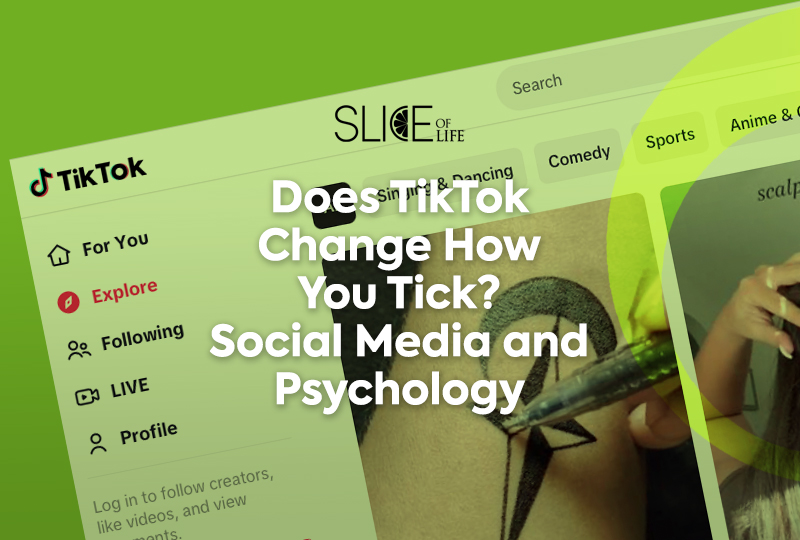Imagine sitting in a boring doctor’s office, with about 10 minutes before a likely call back. Is the impulse to doom scroll through your phone and laugh at the latest TikTok trend dance rather than be alone with your thoughts? That could be a sign of a limited attention span or of a growing dependence on social media. For many people, social media has become something of an unhealthy social coping mechanism and one in which we are only barely beginning to understand the overarching long-term effects.
Baylor University, for example, published a research study in May 2023 that asked 420 U.S. adults to examine defined flow states when using Instagram and TikTok in order to see if these flow states altered well-being. A flow state in the context of the study refers to when a person is so wrapped into a particular activity that they do not appear to notice anything else, even continuing in the activity despite negative outcomes. The five flow states that the study looked at are:
- Focused attention- Absorption into social media
- Enjoyment- Elevated mood while on social media
- Curiosity- This could also be called the Fear of Missing Out or FOMO, which is characterized by the impulse to want to constantly know what is going on on social media.
- Time distortion- This is when it feels like you have lost time on social media, or you spent two hours scrolling when you only thought you would look for five minutes.
- Telepresence- As opposed to focused attention, this is not only an intense awareness of what social media offers but an integration into the world created by the social media experience.
The study found that telepresence and time distortion are most concerning when looking at the possible problematic and addictive qualities of social media. The more that social media is allowed to bleed over into physical, personal behaviors and real-world scenarios, the more engrained it becomes in a person’s everyday habits and patterns. High telepresence was noted in Instagram and TikTok users, with 53% of TikTok users and 38% of Instagram users reporting high telepresence in the study.
It would be compelling to see more research comparing these findings to other popular social media platforms like Facebook and X (formerly Twitter). Concerned social scientists have pointed to a potential correlation between the performative nature of Instagram and especially TikTok, sites with algorithms that reward flashy self or business promotion as well as keeping up with whatever is on trend. Not to mention, when dangerous trend challenges convince impressionable minds to engage in unsafe behaviors, such as the infamous Benadryl Challenge that encouraged people to take insanely high amounts of the over-the-counter medicine, resulting in a number of tragic fatalities.
TikTok is possibly becoming something of a different animal altogether because of the way in which it organizes and optimizes content. The Guardian’s article “What TikTok does to your mental health: ‘It’s embarrassing we know so little’”, raised poignant questions about what happens when someone spends excessive amounts of time on a social media platform designed to feed them the exact kind of content they want in easy-to-digest and colorful bursts. Most social media based its algorithms on engagement metrics, such as clicks, likes or follows of pages. TikTok, on the other hand, has specifically boosted based on minutes and hours of viewing time, so essentially what has been most watched will be more likely to feature more heavily on feeds.
The potentially scary part about social media that relies so heavily on a personalized algorithm as opposed to a healthier mix of chronologically-based content is that studies have found that it can often unintentionally promote extremist views and content. Simply put, loud and radical content does attract attention, so an algorithm will often highlight it purely due to its polarizing nature.
Besides, social media is enough of a ‘ballet in a minefield’ as is even when someone has a fully formed adult mind, but what about kids growing up in this digital environment? The Richmond Journal of Law and Technology reported that TikTok users average 95 minutes a day on the app, roughly between 160-250 videos every day of bite-sized 21-34 second dopamine boosters. Experts are increasingly linking excessive social media use to a palpable shortening of children’s attention spans and even called the observed development “TikTok Brain.” The long-term issues of diminished attention can interfere with goal setting, memory problems and decreased focus. Legislation often follows behind technology, so it may be a long time before any tangible laws are put into place to taper this effect.
Social Media Safeguarding
It’s unrealistic and impractical to try to cut out social media entirely. In fact, social media has many benefits of being able to connect people from all over the world and from all walks of life. The important thing is to never let social media replace real-world connection and socialization. The negative effects of social media can be managed and mitigated in a number of ways, such as:
- Installing and using a screen-time management app or phone settings. Many social media apps offer these within their internal settings.
- If social media appears to be becoming a problem for you, ask a friend to help keep you accountable.
- Set time limits on all the social media apps you use and stick to them.
Like many other things in life, social media is fine in moderation. Educate yourself on the dangers. Be aware of pitfalls and misinformation. Not everything has to be documented for ‘The Gram’ or splashed onto TikTok with the latest soundbite and hashtag. Let social media be a small part of your life, as long as it doesn’t become your life.
For a more in-depth look on Psychology as a career, check out Life University’s B.S. in Psychology or M.S. in Positive Psychology programs.


Social Media